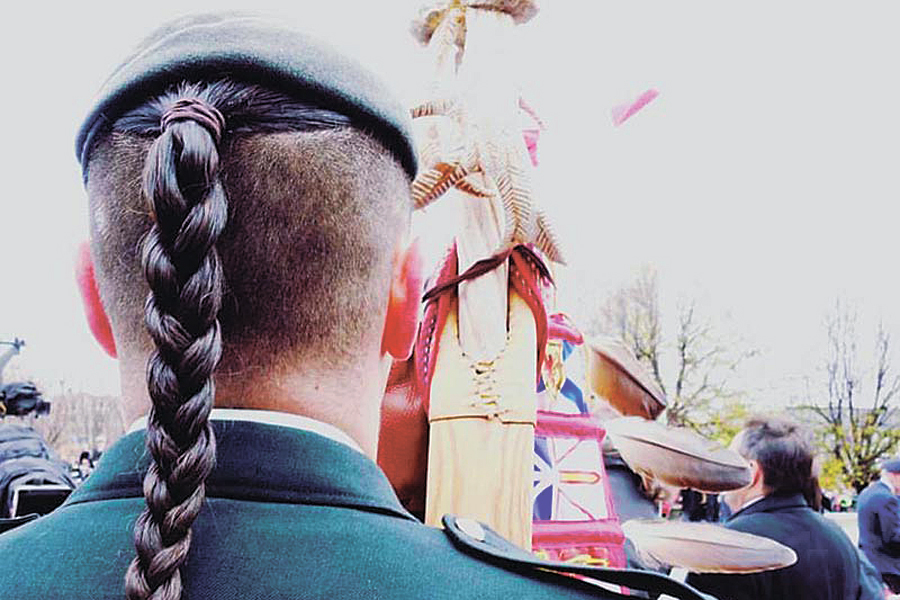Soldier with braids – identity, tradition, pride
By Lookout on Apr 22, 2017 with Comments 2

Sergeant Moogly Tetrault-Hamel
Indigenous Advisor to the Chaplain General ~
Since the mid-1990s, the Canadian Armed Forces (CAF) has supported the right of Indigenous military members to wear their hair in a traditional braid while in uniform. The following story is my reflection on the spiritual and cultural significance of this practice.
Growing my braid is a serious commitment. The traditional process is bound by many protocols, ceremonies and responsibilities.
I have had to cut my hair a few times for traditional reasons. It always was a hard process and felt like my spiritual connections were being severed.
When encountering other traditional Indigenous people, I feel a mutual sentiment of recognition, pride and respect based on the length of our braids. It sometimes feels like a badge of honour.
When visiting communities outside of one’s family circle, for example, a braid is a marker of pride and respect, often designating the wearer as a role model. But this respect is not free. To deserve this honour, one must always sincerely try to carry oneself properly and follow the guidance of the knowledge keepers and sacred teachings.
When one’s hair reaches a certain length, the wearer then plays an even greater role in ceremonial practices, and is encouraged to share knowledge and to assist those in need. These are obligations not to be denied.
Together, my wife and I have four children: three daughters and one son. Our son has short hair because he understands the deep meanings and duties of growing traditional hair.
It will be my son’s choice to grow his braid when he is ready, but it has to come from his heart. All I can do is try my best to show him the way.
As a father, it is most important for me to lead by example and show my children that no matter how much adversity I have faced, I still stand tall and honour my ancestors and our way of life.
Traditional Justice
For thousands of years, in many Indigenous cultures, when an individual would behave in ways that countered the values of the community, the family Elders could demand that his or her hair be cut or shaved off as a public sign of shame and dishonour of oneself and one’s family, both living and dead.
In some cases, the accused would be asked to publicly apologize to the entire community, on his or her own behalf and that of his or her family or clan.
In more extreme situations, banishment from the community could occur.
When the individual was ready to walk on the right path again, he or she would be allowed to return with full support from his or her relatives. As the person’s hair grew back, so too would the trust of the community, with honour and balance restored. Often, an individual would even take the initiative to cut off his or her hair deliberately as a sign of repentance.
Ceremonial Haircuts
The family knowledge keepers advise on matters concerning the hair for both the day-to-day and ceremonial situations. Ceremonial hairstyles and haircuts are integral parts of some union ceremonies, funerals phases, personal quests, rites of passage, healing processes, seasonal ceremonies and so on.
The ritual steps are limited to oral tradition and can often only be shared with the initiated few. Any explanation to someone who did not take part in those ceremonies would be limited to the personal perspective of the individual permitted to share it. Official definitions or explanations can only come from the knowledge keeper or visionary of a particular ceremony.
The honour and privacy of our Indigenous military members deserves our collective respect. CAF members who wear braids do not wear their hair that way simply because they can. Braids are part of their cultural identity and spiritual practice and are worn with great pride.
The CAF Indigenous Hair Policy is not an accommodation, but a right. For more information, reference the A-DH-265-000/AG-001 CAF Dress Instructions and DAOD 5516-3 Religious or Spiritual Accommodation.
Filed Under: Top Stories
About the Author:






In 1997, I was the 1st Aboriginal male in the CAF to wear braids IAW my traditional beliefs. I saved every note and memorandum I sent and received to/from NDHQ Ottawa it took to do this.
This collection of documents will become the property of, “Manitoba Indigenous Cultural Education Centre Inc.”, at a time of my choosing. A sort of going home, another story.
Some day, the good people of Canada can have a first hand view of who accomplished this task and how it was done. Real history.
LS (Ret) SD Prince CD
In 1997, I was the 1st Aboriginal male in the CAF to wear braids IAW my traditional beliefs. I saved every note and memorandum I sent and received to/from NDHQ Ottawa it took to do this.
This collection of documents will become the property of, “Manitoba Indigenous Cultural Education Centre Inc.”, at a time of my choosing. A sort of going home, another story.
Some day, the good people of Canada can have a first hand view of who accomplished this task and how it was done. Real history.